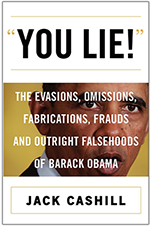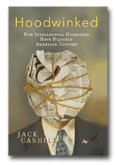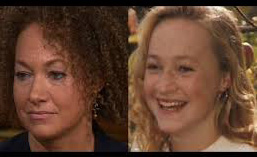Why Is Rachel D Less “Authentic”
Than Barry O?
Jack Cashill's newest book is out:
Get your copy of Jack Cashill's "You Lie!"

___
Also:
Jack Cashill's:
Hoodwinked: How Intellectual Hucksters have Hijacked American Culture

Click here for signed first edition
©Jack Cashill
WND.com -June 17, 2015
If the least attentive of news watchers this past month can identify only two people by sight, one of them is surely Rachel Dolezal (pronounced DOLE-uh-zhal).
 Rachel (left - both images), of course, has spent the last decade passing for a black woman. And say what you will about her authenticity or lack of it, she, unlike other famous transitional types in the news, is not insisting we call her by a new name like, say, “Shamiqua.”
Rachel (left - both images), of course, has spent the last decade passing for a black woman. And say what you will about her authenticity or lack of it, she, unlike other famous transitional types in the news, is not insisting we call her by a new name like, say, “Shamiqua.”
Or “Barack.”
In his memoir, “Dreams from My Father,” Barack Obama tells the story of how he transitioned from “Barry” to “Barack.”
“Regina,” a coed from Chicago’s South Side, somehow found her way to Southern California’s pricy Occidental College. In “Dreams,” Obama described her as “a big, dark woman who wore stockings and dresses that looked homemade.”
Although the character was largely fictional, Obama assigned Regina a tangible real-life task. It was she who convinced Obama to abandon the name “Barry,” a name that presumably sounded much too white and middle class.
“Do you mind if I call you Barack?” she asked. “Not as long as you say it right,” he answered. Coming straight from the motherland, Obama’s baby daddy, Barack Obama Sr., pronounced his name bear-ick, not buh-rock.
Barack Senior himself was known as “Barry” when he was in Hawaii. When Obama visited Africa, well after he became “Barack,” all of his kin called him “Barry.” It was Obama who would contrive the new pronunciation, perhaps because the new pronunciation sounded more forceful, more revolutionary, more black.
In February 2001, as part of an oral history on black America,
Julieanna Richardson interviewed then–state senator Barack
Obama. Obama told Richardson that his childhood in Hawaii was
“idyllic” and that “the image that [he] had of being a black American
was almost exclusively positive.”
He added, “All the children around me were of some mixture, and so I was not unusual or untypical in Hawaii.” He mentioned not a single racial affront.
Obama was either deceiving Richardson or deceiving the readers
of “Dreams.” The evidence suggests the latter. David Remnick,
the author of “The Bridge: The Life and Rise of Barack Obama,” conceded that Obama “darkens the canvas” in “Dreams” and that many
of the grievances cited were “novelistic contrivances.”
The much too generous Remnick insisted that Obama “heightens
whatever opportunity arises” to score a racial point, “obviously”
because he was going “after an emotional truth.”
Biographer David Maraniss, the author of “Barack Obama: The Story,” said much the same thing, claiming Obama portrayed himself as “blacker and more disaffected” than he really was.
“When did you start deceiving people?” Matt Lauer asked Dolezal ealier this week. It was a question he and others should have been asking Obama years ago.
In reviewing Maraniss’s Obama biography, Ben Smith of Buzzfeed
“counted 38 instances in which [Maraniss] convincingly disputes
significant elements of Obama’s own story of his life and his
family history.”
Many of these, perhaps most, were contrived or exaggerated racial slights. To have others accept him as an African American, Obama had a lot of exaggerating to do.
It was never about “truth,” emotional or otherwise. Obama
catalogued his racial slights, real or imagined, to redefine himself
as an African American and to forge a political bond with the black community.
Unlike Dolezal, who seems touchingly deranged, Obama’s identity shift was pure calculation. His choice of church, his choice of wife, his choice of home base—all were designed to “darken the canvas.”
The author Shelby Steele, who is biracial himself and came of age in a segregated world, knows how tempting it is to manufacture grievances.
In his underappreciated 2008 book, “The Bound Man: Why We Are Excited About Obama and Why He Can’t Win,” Steele argued that in his eagerness to seem an “authentic” black man, Obama all too often fictionalized the state of black victimization and cast himself among the victims. He would continue to do this even during his presidency.
As Shelby Steele anticipated, this strategy has not made for good governance. Instead, said Steele, it “commits [Obama] to a manipulation of the very society he seeks to lead.”
”By way of clarification, the “win” in the title of Steele’s prescient book refers not to the outcome of the election, but rather to the fate of the black community under an Obama presidency.
That fate has not been a happy one.
Editor's note: Jack Cashill, newest book, You Lie: The Evasions, Omissions, Fabrications, Frauds and Outright Falsehoods of Barack Obama will be available October 7.

